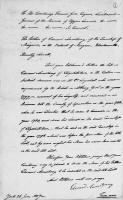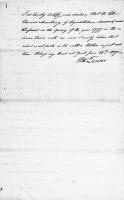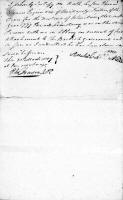Edward Armstrong Jr.
Edward
Armstrong Jr. was born before 1773, in British America, and died Unknown, in
Township of Grantham, Lincoln Co., District
of Niagara, Upper Canada.
He is
the son of
Edward Armstrong Sr. of Unknown, and
Catherine "Caty" Unknown, of Unknown.
Phoebe Mallory was born Unknown, and died Unknown, at age Unknown. She is
the daughter of Andrew Mallory of Unknown, and Mary Whitney of Connecticut.
Edward
Armstrong Jr. and
Phoebe Mallory were possibly married
about 1802, in
Augusta Twp., Leeds Co., Province of Upper Canada.
Edward
Armstrong Jr. and
Phoebe (Mallory) Armstrong had Unknown children.
TIMELINE
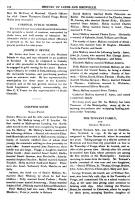
History of Leeds and Grenville that was
written by Thaddeus H. Leavitt, Chapter 28, for the Township of Yonge Front.
The Chapter lists the Mallory family and it lists the family. You want the
second paragraph for Andrew Mallory, the 3rd son of Daniel Mallory
Sr. and Mary Whitney.
Map of Ontario, Canada, in 1791.
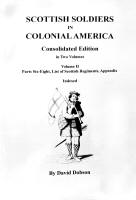
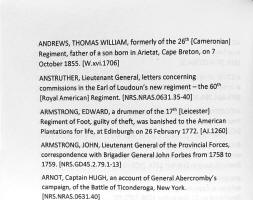
Edward
Armstrong Sr., a U. E.
Loyalist, may have been the soldier who was banished to the American
plantations on February 26, 1772, at Edinburgh

Other Armstrong U. E.
Loyalists who served as Scottish soldiers.
http://www.archives.gov.on.ca/en/maps/index.aspx
ogs.on.ca
https://leedsandgrenville.ogs.on.ca
https://sites.rootsweb.com/~onleedsg/research-census.html
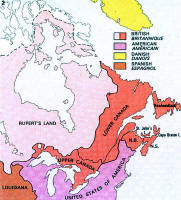
Map of Ontario, Canada, in 1791.
Edward Armstrong Jr. was born
before 1773, in British America.

In May, 1799, John H. Armstrong assigns to
his beloved brother Edward Armstrong Jr., all of his lands in Elizabethtown Twp., Leeds
Co.

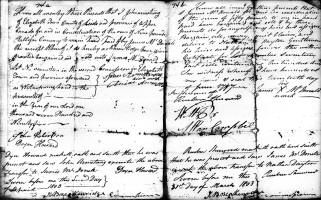
On September 24, 1784, Edward Armstrong Sr., his wife, and three children were
entitled, through a drawing, to three hundred acres of land, in Lot No. 17,
2nd Concession, North.
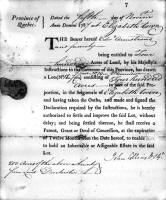
The November 5, 1787, Land Patent Granted to Edward Armstrong and family for 400
acres of land, 200 acres of which are from a bounty from Lord Dorchester.
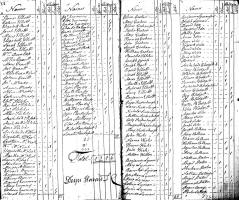
The April 8, 1801, Census for Elizabethtown Twp.,
Leeds Co., Province of Upper Canada, shows the Oliver Graham Family, consisting
of Mary Graham, Oliver Graham Jr., Martin Graham, Mary Graham, Hannah Graham,
John Graham, Sarah Graham, William Graham, and Parmelia Fletcher. Living in the
Edward Fletcher Jr., family are Rachel Fletcher, and children, John Fletcher,
Allen Fletcher, Archibald Fletcher, Archibald Fletcher, and Jane Fletcher.
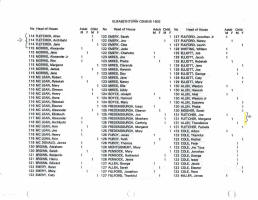
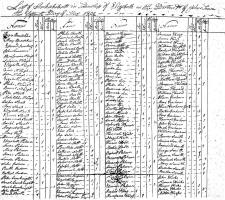
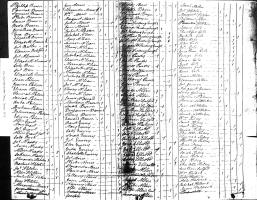
The May 15, 1802, Census for Elizabethtown
Twp., Leeds Co., District of Johnstown, Province of Upper Canada, shows Edward
Armstrong is living by himself. John Fletcher and Margaret
"Maggie" (Armstrong) (Allen) Fletcher, Theodorius Allen and Pamelia Fletcher are living in Family No. 114, Elizabethtown Twp.,
Leeds Co., Province of Upper Canada. Fletcher children, Allen Fletcher,
Archibald Fletcher, and Jane Fletcher are living in Family No. 114. The Oliver
Graham Family, consisting of Mary Graham, Oliver Graham Jr., Martin Graham, Mary
Graham, Hannah Graham, John Graham, Sarah Graham, William Graham. Alexander
Fletcher (adult), Rachel Fletcher (adult), John Fletcher (child), Allin Fletcher
(child), Archibald Fletcher (child), and Jane Fletcher (child). Archibald
Fletcher (adult lives alone.
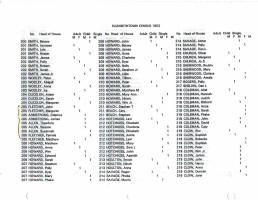
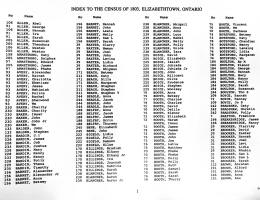

The 1803 Census
for Elizabethtown Twp., Leeds Co., Province of Upper Canada,
shows Catherine
"Caty" (Adams???)
Armstrong is living alone
in Family No.158. John Fletcher,
his wife, Margaret
"Maggie" (Armstrong) (Allen) Fletcher, Adolphus Armstrong, James
Armstrong, Theodora Allen, Weston Allen, Susannah Allen, and Parmelia
Fletcher, are living in Family
No. 205. West Allen, Hannah Allen, and Abel Allen, are living in Family No. 106.
Edward Armstrong Jr. and Phebe Armstrong are living in Family No. 97.
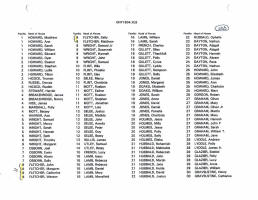
The 1804 Census for Elizabethtown Twp.,
Leeds Co., Province of Upper Canada, shows John Fletcher, his wife, Margaret
"Maggie" (Armstrong) (Allen) Fletcher, Margaret's mother, Catherine
"Caty" (Adams???)
Armstrong (misnamed Fletcher), Matthew Allen (misnamed Fletcher), Susannah Armstrong "Sally/Anne" Allen
(misnamed Fletcher), and Matthew Allen (misnamed Fletcher), are living in
Family No. 205.
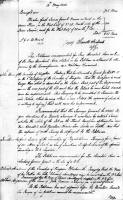

On May 12, 1808, Edward
Armstrong Jr. of Niagara Township, a Blacksmith, requests that the name of his
late father, Edward Armstrong Sr., be inserted on the U. E. List. The request was
Recommended.
Indeed a very large
proportion of the land was shut away altogether from the use of actual settlers.
1. There was first the
Crown reserves – one-seventh of all the lands; these had a mark on them like a
blur made with the end of a finger dipped in pale red ink. These were sold or
granted about that time to the Canada Company, and were open for settlement by
purchase.
2. Then there was another
seventh of the land, with a dusky blur on them, made as if with a finger-tip
dipped in common black ink.
These were the clergy reserves, and at that time might be leased, but not
bought.
3. Besides the above,
there were in all the townships lots with the letter D written upon them, some
in single two-hundred-acre lots, and sometimes in blocks of several hundred or a
thousand acres. These, we are told, belonged to certain great estates of
favoured persons in different parts of the country and deeded to them; and they
were always the best lands, but they were “taboo” to the settler.
Grantham Township,
Lincoln County
The following description of Grantham Township and its
villages is quoted from the Illustrated Historical Atlas of the Counties
of Lincoln and Welland, Ont. Toronto: H.R. Page & Co., 1876.
Township of Grantham
The Township of Grantham is bounded on the north by Lake
Ontario, on the east by the Township of Niagara, on the south by a small
portion of the Township of Stamford, and by the Township of Thorold (Welland
County) and on the west by the Township of Louth. This Township has
about 23,415 acres, and its soil is suitable for raising the usual
crops; and apples, pears, peaches, and the various berries do unusually
well, as they, in fact, do through the whole extent of the Counties of
Lincoln and Welland.
The Township was first settled during the year 1784, when
members of Butler’s Rangers who were discharged during that year,
commenced to clear up land to make homes in the township. Many of those
who received land from the Government considered it worth little, or
nothing and bartered away their sites for mere trifles, and those who
look over the map of Grantham which was made about 1784, or the year
after, will notice the large tracts of land which some persons owned,
and which, in many instances, were bought for sums almost too low to be
called a price.
Grantham Township at the present is flourishing in every
way, and its school system and churches are equal, and in many respects
superior, to those of the other townships.
The British Constitutional Act of 1791
officially divided the old colony of "Province of Quebec" into the primarily
French-speaking "Province of Lower Canada," and the primarily English-speaking
"Province of Upper Canada." Upper Canada was located upriver, closest to the
source of the St. Lawrence river.
In 1841, the Act of Union officially united the two Provinces
into the single Province of Canada, with the creation of Canada East and Canada
West.
Ontario was known as: "Upper Canada" from
December
26, 1791, to February 10, 1841;
"Canada West" from February 10, 1841, to July
1, 1867; and
"Ontario" after July 1, 1867.
Canada was founded on July 1, 1867. On this
date, the colonies of Canada, New Brunswick, and Nova Scotia linked to form the
sovereign dominion of Canada in a process called confederation. At this time,
Upper Canada and Lower Canada became Quebec and Ontario. Therefore the new
confederation comprised of four provinces: Nova Scotia, New Brunswick, Quebec,
and Ontario. The confederation led to a territorial evolution leading to the
incorporation of other parts of British North America into the newly formed
entity of Canada to form what is today contemporary Canada. Newfoundland and
Labrador was the last province to be incorporated into the confederation in
1949. For a period of many years since Confederation, Canada has undergone many
territorial changes and expansions, eventually forming the current union of ten
provinces and three territories.
The formation of Canada and attainment of its
independence was a gradual process. Despite the existence of a responsible
government in Canada, the United Kingdom continued to claim sovereignty over the
land until the end of the World War I. The 1931 passing of the statute of
Westminster recognized Canada as equal with the United Kingdom but the country
was denied the power to amend its constitution. Dependence on the British
parliament in Canada was removed in 1982 after patriation of the constitution.
Canada is a federal parliamentary democracy and a constitutional monarchy, with
Queen Elizabeth II being the head of state.
|
















